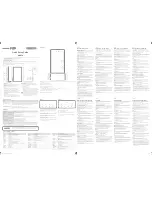
6RL SERIES OPERATION MANUAL
SECTION 7: REMOTE PROGRAMMING
Entire Contents Copyright
2018 by Adaptive Power Systems, Inc. (APS) • All Rights Reserved • No reproduction without written authorization from APS.
6RL Series Regenerative DC Load Operation Manual
Page 114 of 204
The default IP is 198.168.0.2. All other required network parameters for the device/network
interface can be changed or reset to defaults in the setup menu of the unit.
The currently active IP address, along with other network related parameters like gateway,
DNS address, subnet mask and MAC address, can also be read from an overview in the setup
menu of unit where the series features an on-screen setup menu.
The website gives the user full control over the unit by manually typing SCPI commands. It
primarily serves for simple testing purposes. In case you want to continuously control a unit
or at least monitor it, please refer to the SCPI command language section in this manual.
The website’s second CONFIGURATION page allows for setting up network specific
parameters, same as when doing so from the unit setup menu. These are written to the unit
remotely, requiring prior activation of remote control by command SYST:LOCK ON.
7.2.4
TCP Network Access
All interface network modules, as well as the integrated LAN port of select series offer
standard TCP access via the default port 5025 (user-selectable, see unit operating guide for
setup menu). TCP data transfer is used for the external communication via ModBus RTU or
SCPI. Some interface modules feature additional ports, which are reserved and cannot be
changed.
The port and other network related parameters can either be adjusted in the unit's setup
menu (if featured) or from outside via USB or on the website.
TCP/IP socket connection (IP:port) is intended for normal remote control access to the unit.
Note: The TCP connection is automatically disconnected by the unit after a certain amount
of time elapsed with no data transmission. This timeout is by default set to 5
seconds, but can adjusted to higher values. There is also another related option
called "TCP keep-alive" which, if activated, turns the timeout ineffective, unless "TCP
keep-alive" is not configured in the network.
7.2.5
General Unit Communication
After connecting the unit via a digital interface to a PC, it is usually ready for access. Access
can happen in one of several ways:
Via a control and monitoring software supplied by the unit manufacturer
Via LabView VIs, supplied by the unit manufacturer
Via a custom programmed application which is usually created by the user
Via other software, like a terminal program that can send text messages (SCPI)
Via internationally standardized software for CAN, CANopen, Profibus or EtherCAT
etc.
Control locations are those locations from where a unit is accessed. There are basically two:
direct access (manual control) and external access (remote control). The user can switch
between control locations just as the situation requires. Refer to section 6.5.2,”Control
Locations“ on page 80 for more details.
Summary of Contents for 6RL Series
Page 203: ......
















































